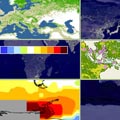


 For millions of years, our ancestors led a precarious existence as scavengers, hunters & gatherers. There were fewer than 10 million people on Earth at any one time. But over the last two centuries, the world's population has skyrocketed. By 1999, some crowded cities had more than 10 million inhabitants each & 6 billion people shared space on the planet.
Trace the dramatic growth & spread of Human Populations on the Global Map.
For millions of years, our ancestors led a precarious existence as scavengers, hunters & gatherers. There were fewer than 10 million people on Earth at any one time. But over the last two centuries, the world's population has skyrocketed. By 1999, some crowded cities had more than 10 million inhabitants each & 6 billion people shared space on the planet.
Trace the dramatic growth & spread of Human Populations on the Global Map.
 For decades environmentalists have warned that ever-rising numbers of people & their overuse of Earth's resources could lead to disaster for wildlife, ecosystems & human populations. As scientists gather & publish more data that graphically reveal the link between population growth & environmental degradation, those warnings are becoming harder to ignore. In this Map-Based Feature, we can see how the big the human "footprint" is on our planet.
For decades environmentalists have warned that ever-rising numbers of people & their overuse of Earth's resources could lead to disaster for wildlife, ecosystems & human populations. As scientists gather & publish more data that graphically reveal the link between population growth & environmental degradation, those warnings are becoming harder to ignore. In this Map-Based Feature, we can see how the big the human "footprint" is on our planet.

|
Population increase is a fundamental driving
force of change. It automatically increases human
consumption of natural resources and releases of
pollution, unless consumption patterns change to
reduce per capita impacts. Historically, rates of
consumption and pollution have been rising faster
than population, both in Canada and globally. The world passed a historic landmark in 2005, when the global population crossed the six billion mark, a doubling since the late 1950s. The rate of population increase is slowing, but is still at about 78 million new inhabitants of Earth every year. Current UN estimates are that we will hit 7 billion in only 13 more years, 8 billion in 28 years and 9 billion by just after mid-century. Although Canada's population is growing slowly, our growth rate is higher than that in most industrialized countries. Our population growth is concentrated in areas with considerable environmental stresses, particularly around Toronto and Vancouver. Global population growth has global impacts that are felt in Canada, including pressures on the environment and demand for products that we export. |
|
 CIA World Factbook
CIA World Factbook![]() Can. Stats
Can. Stats
 Population Pyramids & Scattergraph Skills
Population Pyramids & Scattergraph Skills ![]()
Nat. Geo. Map Machine - World Pop. Density
URBAN
LAND USE ZONES
|
